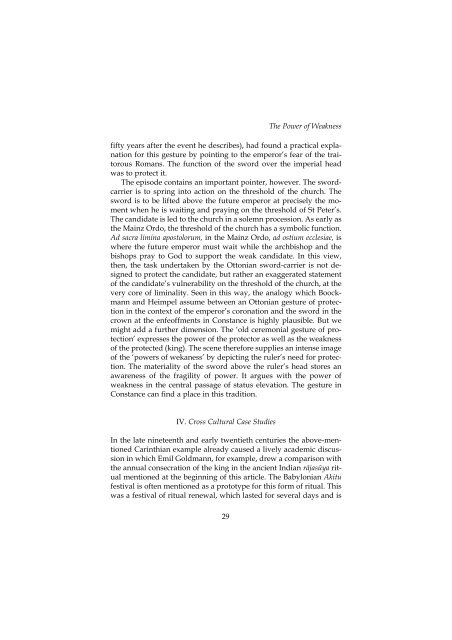The Power of Weakness: Machiavelli Revisited - German Historical ...
The Power of Weakness: Machiavelli Revisited - German Historical ...
The Power of Weakness: Machiavelli Revisited - German Historical ...
You also want an ePaper? Increase the reach of your titles
YUMPU automatically turns print PDFs into web optimized ePapers that Google loves.
fifty years after the event he describes), had found a practical explanation<br />
for this gesture by pointing to the emperor’s fear <strong>of</strong> the traitorous<br />
Romans. <strong>The</strong> function <strong>of</strong> the sword over the imperial head<br />
was to protect it.<br />
<strong>The</strong> episode contains an important pointer, however. <strong>The</strong> swordcarrier<br />
is to spring into action on the threshold <strong>of</strong> the church. <strong>The</strong><br />
sword is to be lifted above the future emperor at precisely the mo -<br />
ment when he is waiting and praying on the threshold <strong>of</strong> St Peter’s.<br />
<strong>The</strong> candidate is led to the church in a solemn procession. As early as<br />
the Mainz Ordo, the threshold <strong>of</strong> the church has a symbolic function.<br />
Ad sacra limina apostolorum, in the Mainz Ordo, ad ostium ecclesiae, is<br />
where the future emperor must wait while the archbishop and the<br />
bishops pray to God to support the weak candidate. In this view,<br />
then, the task undertaken by the Ottonian sword-carrier is not de -<br />
sign ed to protect the candidate, but rather an exaggerated statement<br />
<strong>of</strong> the candidate’s vulnerability on the threshold <strong>of</strong> the church, at the<br />
very core <strong>of</strong> liminality. Seen in this way, the analogy which Boock -<br />
mann and Heimpel assume between an Ottonian gesture <strong>of</strong> protection<br />
in the context <strong>of</strong> the emperor’s coronation and the sword in the<br />
crown at the enfe<strong>of</strong>fments in Constance is highly plausible. But we<br />
might add a further dimension. <strong>The</strong> ‘old ceremonial gesture <strong>of</strong> protection’<br />
expresses the power <strong>of</strong> the protector as well as the weakness<br />
<strong>of</strong> the protected (king). <strong>The</strong> scene therefore supplies an intense image<br />
<strong>of</strong> the ‘powers <strong>of</strong> wekaness’ by depicting the ruler’s need for protection.<br />
<strong>The</strong> materiality <strong>of</strong> the sword above the ruler’s head stores an<br />
awareness <strong>of</strong> the fragility <strong>of</strong> power. It argues with the power <strong>of</strong><br />
weakness in the central passage <strong>of</strong> status elevation. <strong>The</strong> gesture in<br />
Constance can find a place in this tradition.<br />
IV. Cross Cultural Case Studies<br />
In the late nineteenth and early twentieth centuries the above-mentioned<br />
Carinthian example already caused a lively academic discussion<br />
in which Emil Goldmann, for example, drew a comparison with<br />
the annual consecration <strong>of</strong> the king in the ancient Indian rājasūya ritual<br />
mentioned at the beginning <strong>of</strong> this article. <strong>The</strong> Baby lonian Akitu<br />
festival is <strong>of</strong>ten mentioned as a prototype for this form <strong>of</strong> ritual. This<br />
was a festival <strong>of</strong> ritual renewal, which lasted for several days and is<br />
29<br />
<strong>The</strong> <strong>Power</strong> <strong>of</strong> <strong>Weakness</strong>













